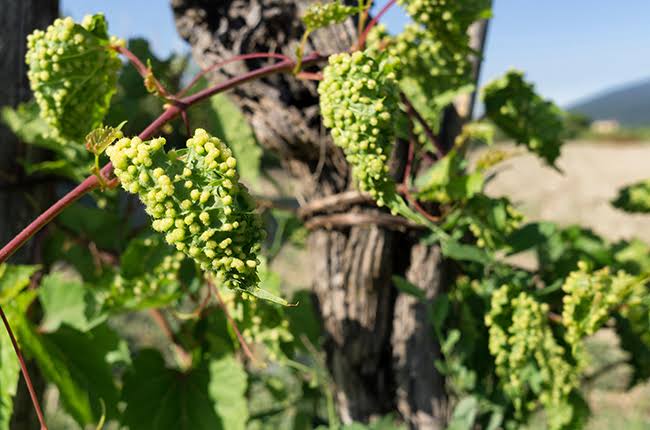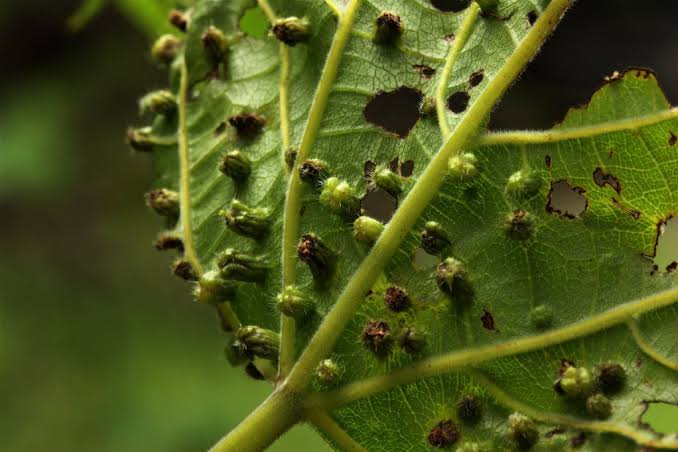Grape Phylloxera: Description, Damages Caused, Control and Preventive Measures
Grape phylloxera, scientifically known as Daktulosphaira vitifoliae, is a tiny insect that has had a significant impact on grapevines worldwide. This little creature, barely visible to the naked eye, has caused big problems for grape growers.
These tiny insects have a big appetite for grape roots. They sneakily insert their needle-like mouthparts into the roots, causing damage that disrupts the flow of water and nutrients. As a result, grapevines become stressed, leading to stunted growth and, eventually, a decline in grape production.
Originally from North America, grape phylloxera made its way to Europe in the late 19th century. This migration brought devastation to vineyards, especially those growing the popular European wine grape varieties. The insects spread rapidly, and vineyards faced economic hardships as their precious grapevines withered away.
Scientists and grape growers had to put on their thinking caps to find a solution. Eventually, they discovered that certain American grapevine species were resistant to the pest. By grafting European grape varieties onto American rootstocks, vineyards could create a sort of insect-resistant superhero plant.
This clever solution saved many grapevines, and the wine industry bounced back. However, not all grape growers embraced this method, as it altered the taste and characteristics of the grapes slightly. The battle against grape phylloxera remains ongoing, with researchers constantly exploring new ways to protect vineyards.
However, while grape phylloxera may be small, its impact on the world of grapes and wine has been immense. Through ingenuity and adaptation, grape growers have managed to combat this tiny foe and preserve the flourishing vineyards we enjoy today.
Read Also: Feijoas: History, Nutrition, Health Benefits and Growing Guide
Plants Affected by Grape Phylloxera (Daktulosphaira vitifoliae)

Grape phylloxera primarily affects grapevines, causing significant damage to their roots. The insect’s scientific name is Daktulosphaira vitifoliae, and it poses a particular threat to European wine grape varieties. These vines, commonly used for winemaking, are susceptible to the feeding habits of grape phylloxera.
The insect inserts its tiny mouthparts into the grapevine’s roots, disrupting the normal flow of water and nutrients. This damage leads to stress in the grapevines, resulting in stunted growth and reduced grape production. The economic impact on vineyards can be severe, as affected plants may ultimately wither and die.
While European wine grape varieties are particularly vulnerable, some North American grapevine species have shown resistance to grape phylloxera. This discovery has led to the practice of grafting European grapevines onto American rootstocks, providing a solution to mitigate the impact of the insect.
It’s important to note that while grape phylloxera is a significant concern for grapevines, its impact extends beyond just the plants themselves. The economic consequences for vineyards and the wine industry as a whole have driven ongoing efforts to find effective strategies for managing and preventing grape phylloxera infestations.
Damages Caused by Grape Phylloxera

Grape phylloxera, scientifically known as Daktulosphaira vitifoliae, inflicts various damages on grapevines, particularly those of European wine grape varieties. The impact of this tiny insect is substantial and extends to both the plants and the economic well-being of vineyards.
One of the primary damages is inflicted on the roots of grapevines. Grape phylloxera inserts its needle-like mouthparts into the roots, causing damage that disrupts the normal flow of water and nutrients. This interference leads to a decline in the overall health of the grapevines, resulting in stunted growth and diminished grape production.
The stress induced by grape phylloxera can weaken the affected grapevines, making them more susceptible to other diseases and environmental stresses. This secondary vulnerability can further exacerbate the overall impact on vineyards, affecting the quality and quantity of grapes harvested.
The economic consequences of grape phylloxera infestations are significant. Vineyard owners may face financial hardships as the affected grapevines decline in productivity or even succumb to the infestation. The cost of implementing measures to control or mitigate the impact of grape phylloxera adds an additional burden on the affected grape-growing regions.
Historically, the arrival of grape phylloxera in European vineyards during the late 19th century led to widespread devastation and economic losses. The wine industry had to adapt by grafting European grape varieties onto resistant American rootstocks, a practice still employed today.
The damages caused by grape phylloxera extend beyond the physical harm to grapevines, impacting the economic sustainability of vineyards and requiring ongoing efforts to manage and prevent infestations.
Moreover, the damages caused by grape phylloxera have prompted ongoing research and innovation within the viticulture community. Scientists and grape growers continually strive to develop new strategies to combat this pest and protect grapevines.
The effects of grape phylloxera are not confined solely to individual vineyards; they have broader implications for the wine industry as a whole. Regions that rely heavily on grape cultivation for winemaking may experience fluctuations in wine production, affecting both local economies and global markets.
As vineyards implement preventive measures, such as choosing resistant rootstocks or employing pest control methods, there is a constant balancing act to maintain the delicate equilibrium between preserving grape quality and minimizing economic losses. The continuous evolution of these practices reflects the resilience and adaptability of the grape-growing industry in the face of persistent challenges posed by grape phylloxera.
Read Also: Pawpaws: History, Nutrition, Health Benefits and Growing Guide
Control and Preventive Measures
Controlling and preventing the impact of grape phylloxera involves a combination of scientific, agricultural, and economic measures. Here are key strategies employed by grape growers to manage and mitigate the effects of this insect:
1. Grafting onto Resistant Rootstocks: One of the primary methods involves grafting European grape varieties onto rootstocks from North American grapevines, which have shown resistance to grape phylloxera. This practice creates a more resilient grapevine, as the root system remains protected.
2. Soil Treatments: Soil treatments, such as the application of insecticides or nematicides, can help control grape phylloxera populations in infested vineyards. However, these methods may have environmental considerations, and their effectiveness may vary.
3. Resistant Grape Varieties: Breeding programs focus on developing grape varieties that are naturally resistant to grape phylloxera. This genetic approach aims to create vines that can withstand the insect’s attacks without the need for extensive human intervention.
4. Monitoring and Early Detection: Regular monitoring of vineyards for signs of grape phylloxera infestation is crucial. Early detection allows growers to implement control measures before the infestation becomes widespread, minimizing the impact on grapevines.
5. Integrated Pest Management (IPM): Integrated Pest Management involves a holistic approach that combines various strategies to control pests, including grape phylloxera, while minimizing environmental impact. This approach may include cultural practices, biological controls, and judicious use of pesticides.
6. Quarantine Measures: Implementing quarantine measures helps prevent the spread of grape phylloxera to uninfested areas. This involves restricting the movement of plant material, soil, or equipment that could potentially carry the insect.
7. Research and Education: Ongoing research into the biology and behavior of grape phylloxera contributes to the development of more effective control methods. Education programs help grape growers stay informed about the latest advancements and best practices.
The dynamic nature of these strategies reflects the continuous effort to strike a balance between preserving grape quality and minimizing the environmental impact of pest control measures.
Frequently Asked Questions (FAQs) About Grape Phylloxera (Daktulosphaira vitifoliae)
Q1: What is grape phylloxera?
A1: Grape phylloxera, scientifically known as Daktulosphaira vitifoliae, is a tiny insect that feeds on grapevine roots, causing damage and affecting the overall health of grapevines.
Q2: How does grape phylloxera damage grapevines?
A2: Grape phylloxera damages grapevines by inserting its mouthparts into the roots, disrupting the flow of water and nutrients. This can lead to stunted growth, reduced grape production, and increased vulnerability to other stresses.
Q3: Where did grape phylloxera originate?
A3: Grape phylloxera is originally from North America. It was inadvertently introduced to Europe in the late 19th century, causing widespread devastation in vineyards.
Q4: Which grape varieties are most affected by grape phylloxera?
A4: European wine grape varieties are particularly susceptible to grape phylloxera. These include popular varieties used in winemaking, such as Cabernet Sauvignon, Chardonnay, and Merlot.
Q5: How can grape growers control grape phylloxera?
A5: Grape growers employ various strategies, including grafting onto resistant rootstocks, soil treatments, using resistant grape varieties, monitoring, and implementing integrated pest management practices.
Q6: Can grape phylloxera be eradicated completely?
A6: Complete eradication of grape phylloxera is challenging. However, effective control measures can be implemented to manage its impact and prevent widespread infestations.
Q7: What are the economic consequences of grape phylloxera infestations?
A7: Grape phylloxera infestations can lead to economic losses for vineyard owners due to reduced grape production and the cost of implementing control measures.
Q8: Is there ongoing research to combat grape phylloxera?
A8: Yes, ongoing research focuses on developing new control methods, breeding resistant grape varieties, and understanding the biology of grape phylloxera to enhance preventive measures.
Q9: Can grape phylloxera spread to other regions?
A9: Yes, grape phylloxera can spread to other regions if proper quarantine measures are not in place. Movement of infested plant material, soil, or equipment can contribute to its spread.
Q10: How can consumers support vineyards affected by grape phylloxera?
A10: Consumers can support affected vineyards by choosing wines made from grape varieties grafted onto resistant rootstocks and staying informed about sustainable viticulture practices.
Read Also: Learning and its 7 Importance to Business Growth









